Optimal Reconfiguration of Distribution Network Considering Stochastic Wind Energy and Load Variation Using Hybrid SAMPSO Optimization Method
Abstract
1. Introduction
1.1. Paper Contribution and Motivation
- The resolution of both static and dynamic reconfiguration problems affecting the RDN by considering various scenarios, which are the SRRDN on a specific point of load consumption with and without DGs integration, the SRRDN over different load levels, the DRRDN following a stochastic variation in daily load consumption curve, and, finally, the DRRDN following the stochastic integration of WTDG and variation in daily load consumption curve.
- A hybrid SAMPSO optimization method, combining the SA algorithm with the MPSO method, is proposed in this work to find the optimal configuration of the DN (global solution).
- In order to quickly sort solutions, lead to notable improvements in the systems’ performance, and enhance network profitability, reliability, and feasibility under several conditions, the suggested metaheuristic optimization method is combined with an open-source MATLAB toolbox, called MATPOWER, for power flow calculation.
- The suggested SAMPSO method is validated on the standard IEEE 69-bus RDN by satisfying technical objectives such as TAPL reduction and voltage profile improvement. The minimization of switching costs is also considered when applying the DRRDN.
- The superiority of the SAMPSO method is demonstrated by comparing its results with other existing techniques.
- Broadly speaking, this improved and tested optimization technique can be applied in other future works on the existing offshore ASHTART network of the Company for Study, Research and Exploitation of Petroleum in Tunisia, named SEREPT, with the aim to continue this research direction, to develop this promising remote region, and to apply the proposed technique in the real-world.
1.2. Paper Organization
2. Problem Formulation
2.1. Reconfiguration Technique
- Loop 1: {L2 L4 L5}
- Loop 2: {L1 L3 L4}
- Loop 3: {L5 L6 L7}
2.2. Objective Function, Premises, and Constraints
- (i)
- Voltage constraint:
- (ii)
- The main bus voltage is 1 pu.
- (iii)
- Load flow constraint:
- (iv)
- Network topological constraints which simultaneously take into account the radial structure of the DN and uninterrupted loads [35].
- (i)
- The load is modeled as a uniform constant power during the SR and as a stochastic power during the DR.
- (ii)
- The DG unit is connected to represent a PQ-type bus. Hence, it generates only active power and it is considered a negative power injection (same for the WTDG).
- (iii)
- Wind power injected into the RDN during the insertion of WTDG is produced from a doubly fed asynchronous machine (MADA).
| Bus number. | |
| Total number of branches. | |
| Switch state of outgoing branch of bus X, where 0 means open state and 1 means closed state. | |
| Resistance of outgoing branch of bus . | |
| Active power flowing out from bus . | |
| Reactive power flowing out from bus . | |
| DG’s active and reactive powers into bus . | |
| Active power losses in outgoing branch of bus . | |
| Active load power in outgoing branch of bus . | |
| Voltage at bus . | |
| Minimum allowable voltage of VX . | |
| Maximum allowable voltage of VX (. | |
| Current of outgoing branch of bus | |
| Maximum allowable current of . |
2.3. Power Flow Calculation Procedure
3. Proposed Hybrid SAMPSO Optimization Method
3.1. Simulated Annealing Algorithm (SA)
- (i)
- Starting from a known fundamental state with particles of the solid arranged in a highly structured network with the minimum energy of the system;
- (ii)
- Heating the solid by increasing its temperature (T) in a heat bath until the solid melts into a liquid and obtains randomly arranged particles;
- (iii)
- Lowering its temperature slowly.
- (i)
- Initialization;
- (ii)
- Cooling rate;
- (iii)
- Upgrade;
- (iv)
- Probability of approval of the research procedure.
3.2. Modified Particle Swarm Optimization (MPSO)
- (i)
- The use of the sigmoid function in the control of the rate of variation of the particles to obtain perfect solutions.
- (ii)
- The exploitation of all the search space to discover the best solution as quickly as possible.
- (iii)
- The use of a better method to improve the convergence of the population and reduce the number of possible iterations.
| Inertia weight factor ( 0). | |
| K | Current iteration number. |
| Acceleration coefficients ( 0). | |
| , | Random numbers within the range [0, 1]. |
| Velocity of particle in the search space at iteration k. | |
| Current position of particle i in the search space at iteration k. | |
| , | Minimum and maximum inertia factor weights. |
| Maximum number of iterations. |
3.3. A Hybrid SAMPSO Algorithm Combined with the MATPOWER Toolbox
- Step 1.
- Load case information: the system data, generator data, bus data, and branch data, are saved in a MATPOWER case file.
- Step 2.
- Calculate voltages at each node and total power loss in the distribution network at the initial state using the MATPOWER toolbox.
- Step 3.
- Initialize the temperature parameter Tmax.
- Step 4.
- Set a temperature change counter n = 0 and a repetition counter K at each temperature value.
- Step 5.
- Generate a random configuration, Xi, for the search space, S.
- Step 6.
- Check the radial configuration of the distributed network.
- Step 7.
- Initialize the Swarm parameters: define the bounds of the velocity, Vbmax and Vbmin, specify the inertial weight, w, and the values of the acceleration coefficients, c1 and c2, and assign the initial position Xi = [xi1, xi2, …, xin] and velocity Vbi = [vbi1, vbi2, …, vbin] randomly.
- Step 8.
- Compute the fitness function for each particle, f(X0i).
- Step 9.
- Find fitness value of fitness function, Fbest0=min(f(X0i)).
- Step 10.
- Update the weight coefficient, velocity, and position of the particle using Equations (5)–(7), respectively.
- Step 11.
- Calculate PF for an updated particle with the MATPOWER toolbox, check the network’s radiality, and display all results.
- Step 12.
- Compute the new fitness function for each particle, f(Xi), using updated particle position and velocity.
- Step 13.
- Find Fbest = min(f(Xi)).
- Step 14.
- Set the new Pbest,i, and the corresponding new fitness function, Fbest,i.
- Step 15.
- Update new Pbest and Gbest; if the fitness fuction Fbest,i < Fbest, then update Gbest = Pbest,i and Fbest = Fbest,i.
- Step 16.
- Calculate ∆= Fbest0 − Fbest,i.
- Step 17.
- If ∆ < 0, then X0i = Xi; if random (0,1) < exp(−∆/T), then X0i = Xi.
- Step 18.
- Repeat the above procedure (K = K + 1 and n = n + 1) starting with step 10 until the stopping criterion and print out the optimal solution to the target problem.
4. Simulation Results and Discussion
4.1. Simulation Procedure
- (i)
- Scenario 1: Static reconfiguration of the test system at a normal load level characterized by a specific point of load consumption.
- (ii)
- Scenario 2: Static reconfiguration of the test system at a normal load level with an optimal integration of DGs. It can be mentioned here that DGs with an optimal size and placement are used based on the results of previous work given in [44].
- (iii)
- Scenario 3: Static reconfiguration of the test system at different load levels.
- (iv)
- Scenario 4: Dynamic reconfiguration of the test system following a stochastic variation in the daily load consumption curve.
- (v)
- Scenario 5: Dynamic reconfiguration of the test system following the stochastic integration of WTDG and variation in the daily load consumption curve.
4.2. Simulation Results for the Static Reconfiguration of the Standard IEEE 69-Bus RDN
4.2.1. Scenario 1
4.2.2. Scenario 2
4.2.3. Scenario 3
- (i)
- Normal load (NL) for each bus of the RDN (μ = 1),
- (ii)
- Light load (LL) is obtained when the value of the normal load is reduced by 10% (μ = 0.9),
- (iii)
- Heavy load (HL) resulting from a 30% increase in the value of the normal load for the RD buses (μ = 1.3).
4.3. Simulation Results for the Dynamic Reconfiguration of Standard IEEE 69-Bus RDN
4.3.1. Scenario 4
4.3.2. Scenario 5
5. Conclusions
Author Contributions
Funding
Institutional Review Board Statement
Informed Consent Statement
Data Availability Statement
Conflicts of Interest
References
- Ghaeth, F.; Omar, I.F.; Josef, T. Voltage regulation and power losses reduction in a wind farm integrated MV distribution network. J. Electr. Eng. 2018, 69, 85–92. [Google Scholar]
- De Jesús, J.S.J.; Jesús, M.L.L. Alternative methodology to calculate the directional characteristic settings of directional overcurrent relays in transmission and distribution networks. Energies 2019, 12, 3779. [Google Scholar]
- Danilo, S.Z.S.; María, L.L.J.; Nicolás, M.G. Optimal coordination of overcurrent relays in microgrids considering a non-standard characteristic. Energies 2020, 13, 922. [Google Scholar]
- Sushrut, T.H.; Vijay, A.S.; Suryanarayana, E.D. System reconfiguration in microgrids. Sustain. Energy Grids Netw. 2019, 17, 100191. [Google Scholar]
- García-Montoya, C.A.; López-Lezama, J.M. Caracterización del Costo de Distribución de Energía Eléctrica Mediante Modelos de Fronteras de Eficiencia considerando un Indicador de Calidad del Servicio. Inf. Tecnológica 2017, 28, 37–46. [Google Scholar] [CrossRef][Green Version]
- Gregorio, M.D.; Javier, C.; José, M.A. Distribution system expansion planning considering non-utility-owned DG and an independent distribution system operator. IEEE Trans. Power Syst. 2019, 34, 2588–2597. [Google Scholar]
- Chaorui, Z.H.; Jiayong, L.I.; Jun, Z.H.Y. Optimal location planning of renewable distributed generation units in distribution networks: An analytical approach. IEEE Trans. Power Syst. 2017, 33, 2742–2753. [Google Scholar]
- Meisam, M.; Haes, A.L.H.; Nikos, D.H.A. An efficient mathematical model for distribution system reconfiguration using AMPL. IEEE Access 2021, 9, 79961–79993. [Google Scholar]
- Meisam, M.; Rubén, R. Reconfiguration of radial distribution systems: An efficient mathematical model. IEEE Lat. Am. Trans. 2021, 19, 1172–1181. [Google Scholar]
- Mohamed, A.A.B.; Zeinab, H.O.; Mostafa, E.L. New analytical approach for simultaneous feeder reconfiguration and DG hosting allocation in radial distribution networks. Ain Shams Eng. J. 2021, 12, 1823–1837. [Google Scholar]
- El-Ela, A.A.A.; El-Sehiemy, R.A.; Shaheen, A.M. Optimal allocation of DGs with network reconfiguration using improved spotted hyena algorithm. WSEAS Trans. Power Syst. 2020, 15, 60–67. [Google Scholar] [CrossRef]
- Mohammad-Hossein, S.H.; Mahmoud-Reza, H.A.; Javad, S. Duration based reconfiguration of electric distribution networks using dynamic programming and harmony search algorithm. Int. J. Electr. Power Energy Syst. 2012, 41, 1–10. [Google Scholar]
- Damir, J.; Rade, Č.; Josip, V. Optimal reconfiguration of distribution networks using hybrid heuristic-genetic algorithm. Energies 2020, 13, 1544. [Google Scholar]
- Thanh, N.T.; Trung, N.T.; Anh, T. Viet Multi-objective electric distribution network reconfiguration solution using runner-root algorithm. Appl. Soft Comput. 2017, 52, 93–108. [Google Scholar]
- Wang, X.; Liu, X.; Jian, S.; Peng, X.; Yuan, H.A. distribution network reconfiguration method based on comprehensive analysis of operation scenarios in the long-term time period. Energy Rep. 2021, 7, 369–379. [Google Scholar] [CrossRef]
- Dieu, V.O.; Nguyen, A.T. Distribution network reconfiguration for power loss reduction and voltage profile improvement using chaotic stochastic fractal search algorithm. Complexity 2020. [Google Scholar] [CrossRef]
- Shaheen, A.M.; ElsayedbRaga, A.M.; El-Sehiemy, A.; Abdelaziz, A.Y. Equilibrium optimization algorithm for network reconfiguration and distributed generation allocation in power systems. Appl. Soft Comput. 2021, 98, 106867. [Google Scholar] [CrossRef]
- Afshin, F.; Mohammad, H.; Brent, S.T. Equilibrium optimizer: A novel optimization algorithm. Knowl. Based Syst. 2020, 191, 105190. [Google Scholar]
- Josephy, D.S.; Frederico, M.; Negrete, G.; Paola, L. A Novel Solution Method for the Distribution Network Reconfiguration Problem Based on a Search Mechanism Enhancement of the Improved Harmony Search Algorithm. Energies 2022, 15, 2083. [Google Scholar]
- Liu, Q.; Ji, X.; Wang, H. Dynamic reconfiguration of active distribution system based on matrix shifting operation and interval merger. J. Electr. Eng. Technol. 2020, 15, 621–633. [Google Scholar] [CrossRef]
- Ali, J.N.; Manoochehr, B.; Saber, A.N. Meta-heuristic matrix moth–flame algorithm for optimal reconfiguration of distribution networks and placement of solar and wind renewable sources considering reliability. Environ. Technol. Innov. 2020, 20, 101118. [Google Scholar]
- Amirreza, N.; Zulkurnain, A.M.; Masoud, V. Zahedi Optimal, reliable and cost-effective framework of photovoltaic-wind-battery energy system design considering outage concept using grey wolf optimizer algorithm—Case study for Iran. IEEE Access 2019, 7, 182611–182623. [Google Scholar]
- Morad, A. Distribution network reconfiguration using a genetic algorithm with varying population size. Electr. Power Syst. Res. 2017, 142, 9–11. [Google Scholar]
- Usharani, R.; Sivkumar, M. An improved sine–cosine algorithm for simultaneous network reconfiguration and DG allocation in power distribution systems. Appl. Soft Comput. 2020, 92, 106293. [Google Scholar]
- Raoni, P.; Zocimo, Ñ.; Yuri, M. Radial distribution network reconfiguration for power losses reduction based on improved selective BPSO. Electr. Power Syst. Res. 2019, 169, 206–213. [Google Scholar]
- Shukla, J.; Panigrahi, B.K.; Ray, P.K. Stochastic reconfiguration of distribution system considering stability, correlated loads and renewable energy based DGs with varying penetration. Sustain. Energy Grids Netw. 2020, 23, 100366. [Google Scholar] [CrossRef]
- Amirreza, N.; Aldrin, A.B.; Hedayati, M.M. An improved corona-virus herd immunity optimizer algorithm for network reconfiguration based on fuzzy multi-criteria approach. Expert Syst. Appl. 2022, 187, 115914. [Google Scholar]
- Zhai, H.F.; Yang, M.; Chen, B.; Kang, N. Dynamic reconfiguration of three-phase unbalanced distribution networks. Int. J. Electr. Power Energy Syst. 2018, 99, 1–10. [Google Scholar] [CrossRef]
- Gerez, C.; Coelho Marques Costa, E.; Sguarezi Filho, A.J. Distribution Network Reconfiguration Considering Voltage and Current Unbalance Indexes and Variable Demand Solved through a Selective Bio-Inspired Metaheuristic. Energies 2022, 15, 1686. [Google Scholar] [CrossRef]
- Hadidian, M.M.J.; Akhtar, K.; Juan, S.H. A new model for reconfiguration and distributed generation allocation in distribution network considering power quality indices and network losses. IEEE Syst. J. 2020, 14, 3530–3538. [Google Scholar]
- Ibrahim, A.I.; Hamdy, A.; Nagi, F. Radial distribution network reconfiguration for power losses reduction using a modified particle swarm optimisation. CIRED-Open Access Proc. J. 2017, 1, 2505–2508. [Google Scholar]
- Priyesh, K. Network reconfiguration of distribution system using particle swarm optimization. Int. J. Eng. Comput. Sci. 2016, 5, 17369–17374. [Google Scholar]
- Latreche, Y.; Bouchekara, H.R.; Kerrour, F. Comprehensive review on the optimal integration of distributed generation in distribution systems. J. Renew. Sustain. Energy 2018, 10, 055303. [Google Scholar] [CrossRef]
- Anuj, B.; Kumar, S.H.N.; Raj, S.Y. Optimal location and rating of wind power plants in competitive electricity market. J. Renew. Sustain. Energy 2017, 9, 043306. [Google Scholar]
- Raida, S.; Rafik, N.; Tarek, B. Enhancing radial distribution network performance by optimal reconfiguration with PSO algorithm. In Proceedings of the 16th International Multi-Conference on Systems, Signals & Devices (SSD), IEEE, Istanbul, Turkey, 21–24 March 2019; pp. 180–186. [Google Scholar]
- Zhu, J.; Zimmerman, R.D.; Murillo-Sanchez, C.E. MATPOWER 5.1 User’s Manual. March 2015, 14, 15–16. [Google Scholar]
- Duncan, G.J.; Mulukutla, S.S.; Thomas, O. Power System Analysis & Design, SI Version; Cengage Learning: Stamford, CT, USA, 2012. [Google Scholar]
- Jeon, Y.J.; Kim, J.C.; Kim, J.O.; Shin, J.R.; Lee, K.Y. An efficient simulated annealing algorithm for network reconfiguration in large-scale distribution systems. IEEE Trans. Power Deliv. 2002, 17, 1070–1078. [Google Scholar] [CrossRef]
- Kirkpatrick, S.; Gelatt, C.D., Jr.; Vecchi, M.P. Optimization by simulated annealing. Science 1983, 220, 671–680. [Google Scholar] [CrossRef] [PubMed]
- Eberhar, R.; Kennedy, J. A new optimizer using particle swarm theory. In Proceedings of the MHS’95, Proceedings of the Sixth International Symposium on Micro Machine and Human Science, Nagoya, Japan, 4–6 October 1995; pp. 39–43. [Google Scholar]
- Deng, W.; Yao, R.; Zhao, H.; Yang, X.; Li, G. A novel intelligent diagnosis method using optimal LS-SVM with improved PSO algorithm. Soft Comput. 2019, 23, 2445–2462. [Google Scholar] [CrossRef]
- Patel, N.K.; Suthar, B.N. Notice of Removal: Optimal reactive power dispatch using particle swarm optimization in deregulated environment. In Proceedings of the 2015 International Conference on Electrical, Electronics, Signals, Communication and Optimization (EESCO), Visakhapatnam, India, 24–25 January 2015; pp. 1–5. [Google Scholar]
- Sundaram, P.; Ranjit, R.O.Y. Particle swarm optimization based optimal reactive power dispatch. In Proceedings of the 2015 IEEE International Conference on Electrical, Computer and Communication Technologies (ICECCT), Coimbatore, India, 5–7 March 2015; pp. 1–5. [Google Scholar]
- Sellami, R.; Sher, F.; Neji, R. An improved MOPSO algorithm for optimal sizing & placement of distributed generation: A case study of the Tunisian offshore distribution network (ASHTART). Energy Rep. 2022, 8, 6960–6975. [Google Scholar]
- Zimmerman, R.D.; Murillo-Sánchez, C.E.; Gan, D. Matpower, PSERC. 1997. Available online: http://www.pserc.cornell.edu/matpower (accessed on 7 March 2022).
- Daniel, Z.R.; Edmundo, M.S.C.; John, T.H.R. MATPOWER: Steady-state operations, planning, and analysis tools for power systems research and education. IEEE Trans. Power Syst. 2010, 26, 12–19. [Google Scholar]
- TranaKho, T.T.; Truong, H.; Vo, D.N. Stochastic fractal search algorithm for reconfiguration of distribution networks with distributed generations. Ain Shams Eng. J. 2020, 11, 389–407. [Google Scholar]
- Vannak, V.; Sievlong, S.; Rathana, L. Optimal reconfiguration in distribution systems with distributed generations based on modified sequential switch opening and exchange. Appl. Sci. 2021, 11, 2146. [Google Scholar]
- Sirine, E.S.; Adel, K.H. Optimization of distribution system operation by network reconfiguration and DG integration using MPSO algorithm. Renew. Energy Focus 2020, 34, 37–46. [Google Scholar]
- Usharani, R.; Sivkumar, M. An improved Elitist–Jaya algorithm for simultaneous network reconfiguration and DG allocation in power distribution systems. Renew. Energy Focus 2019, 30, 92–106. [Google Scholar]
- Hamouda, A.M.; Mohammed, M.E.; Elsaied, O. Optimal Network Reconfiguration Incorporating with Renewable Energy Sources in Radial Distribution Networks. Int. J. Adv. Sci. Technol. 2020, 29, 3114–3133. [Google Scholar]
- Raida, S.; Nahla, B.H.; Imen, K.H. Optimal network reconfiguration following hourly variations of load demand and wind generation. J. Electr. Syst. 2020, 16, 146–162. [Google Scholar]


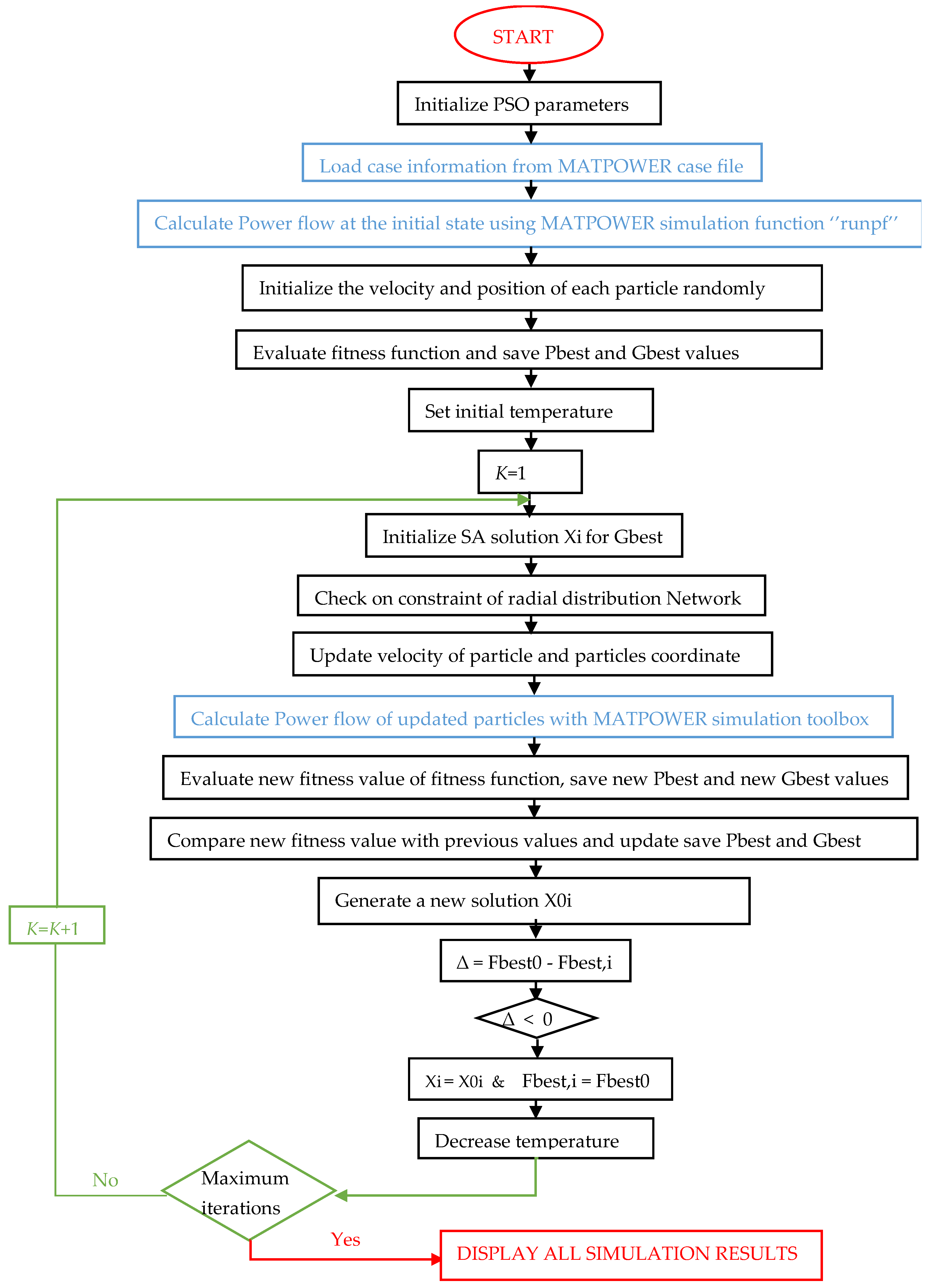
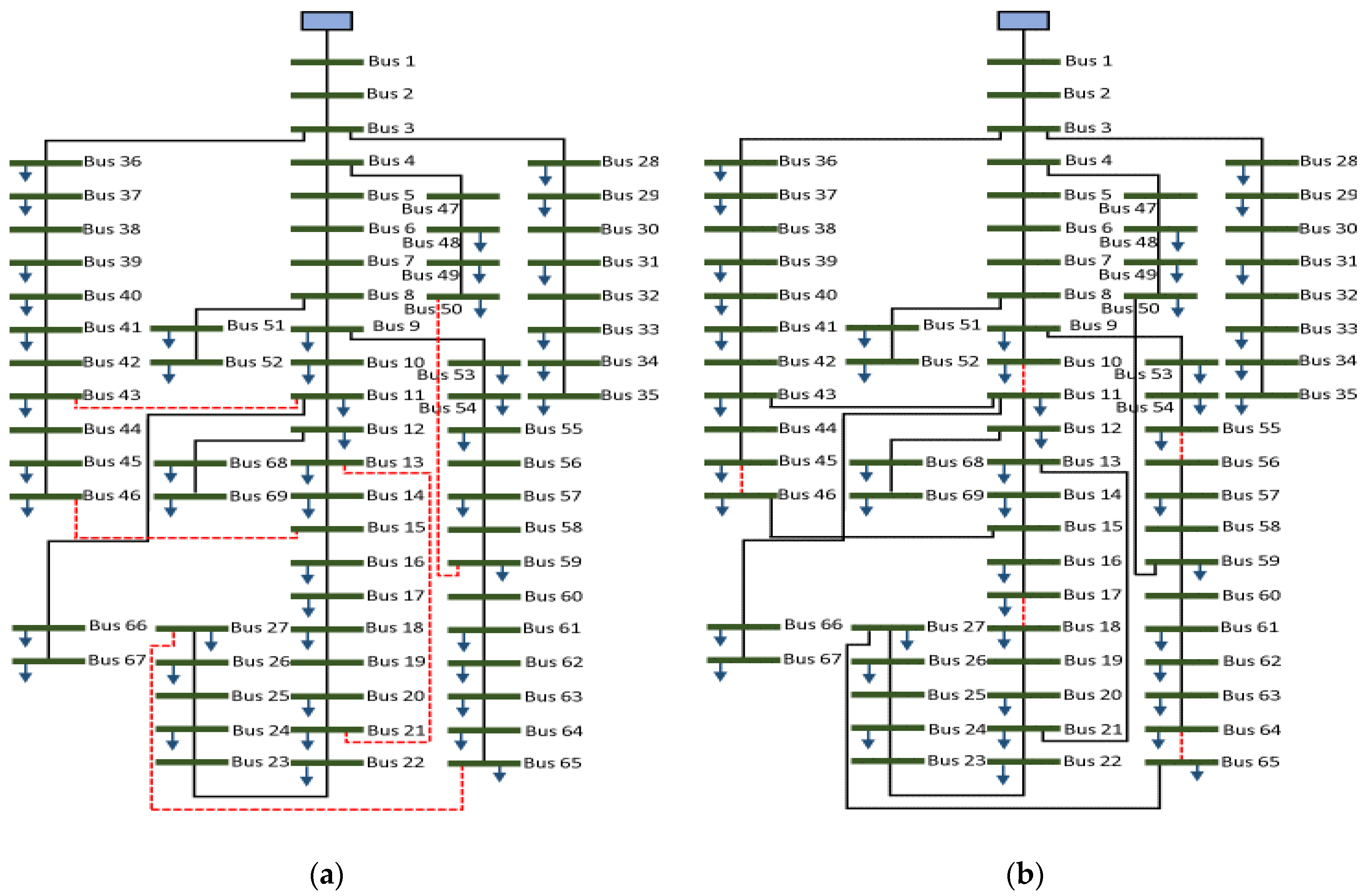
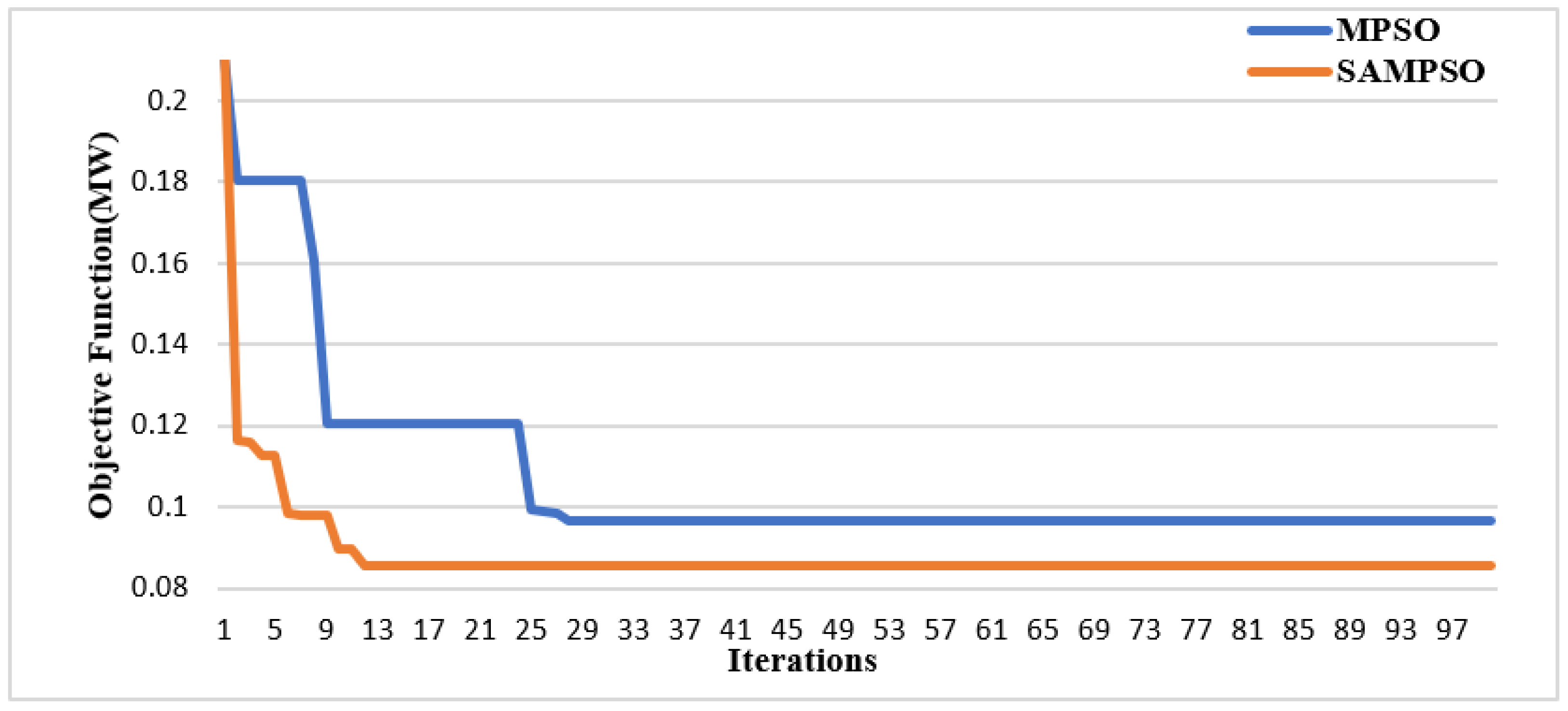
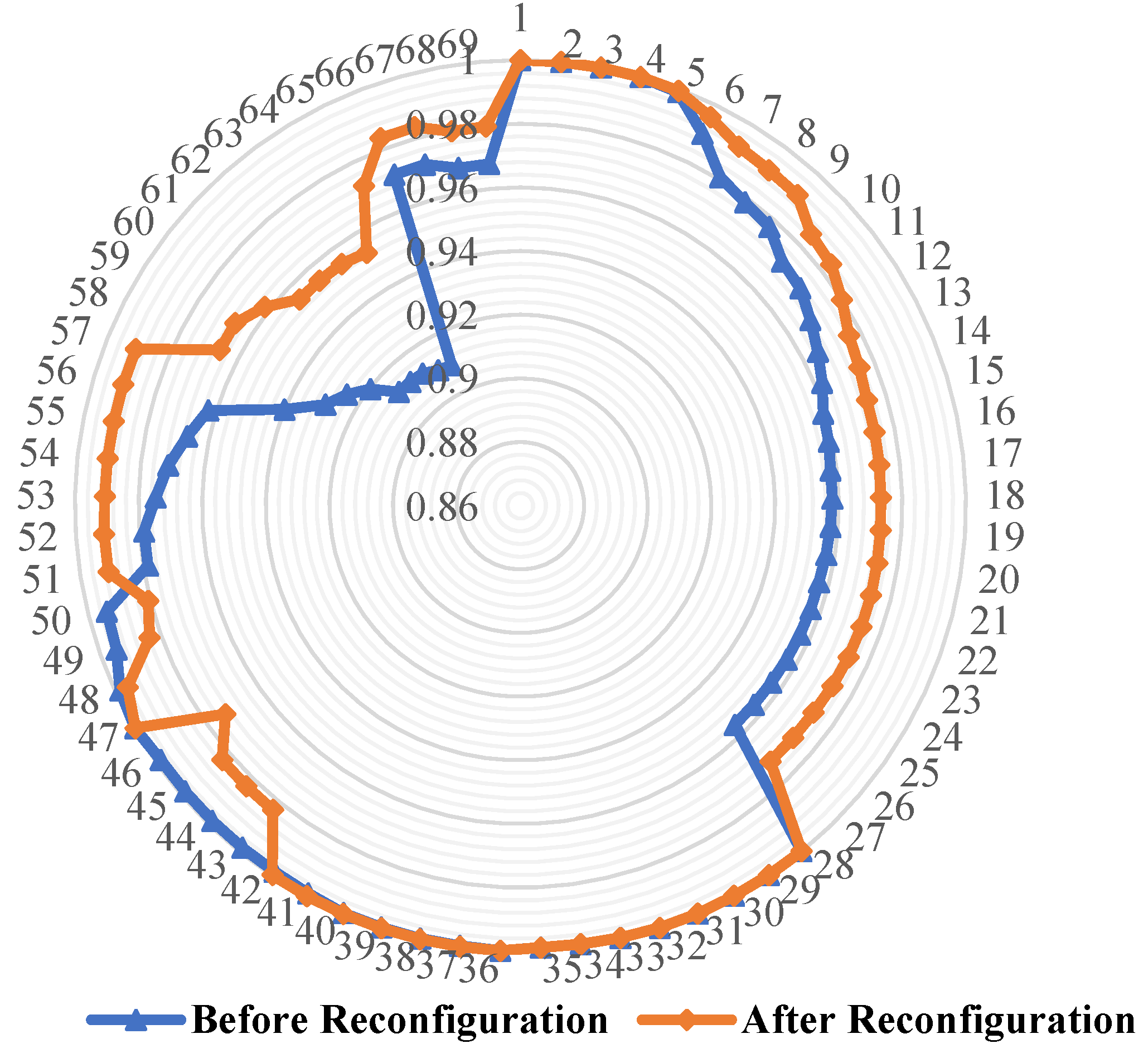
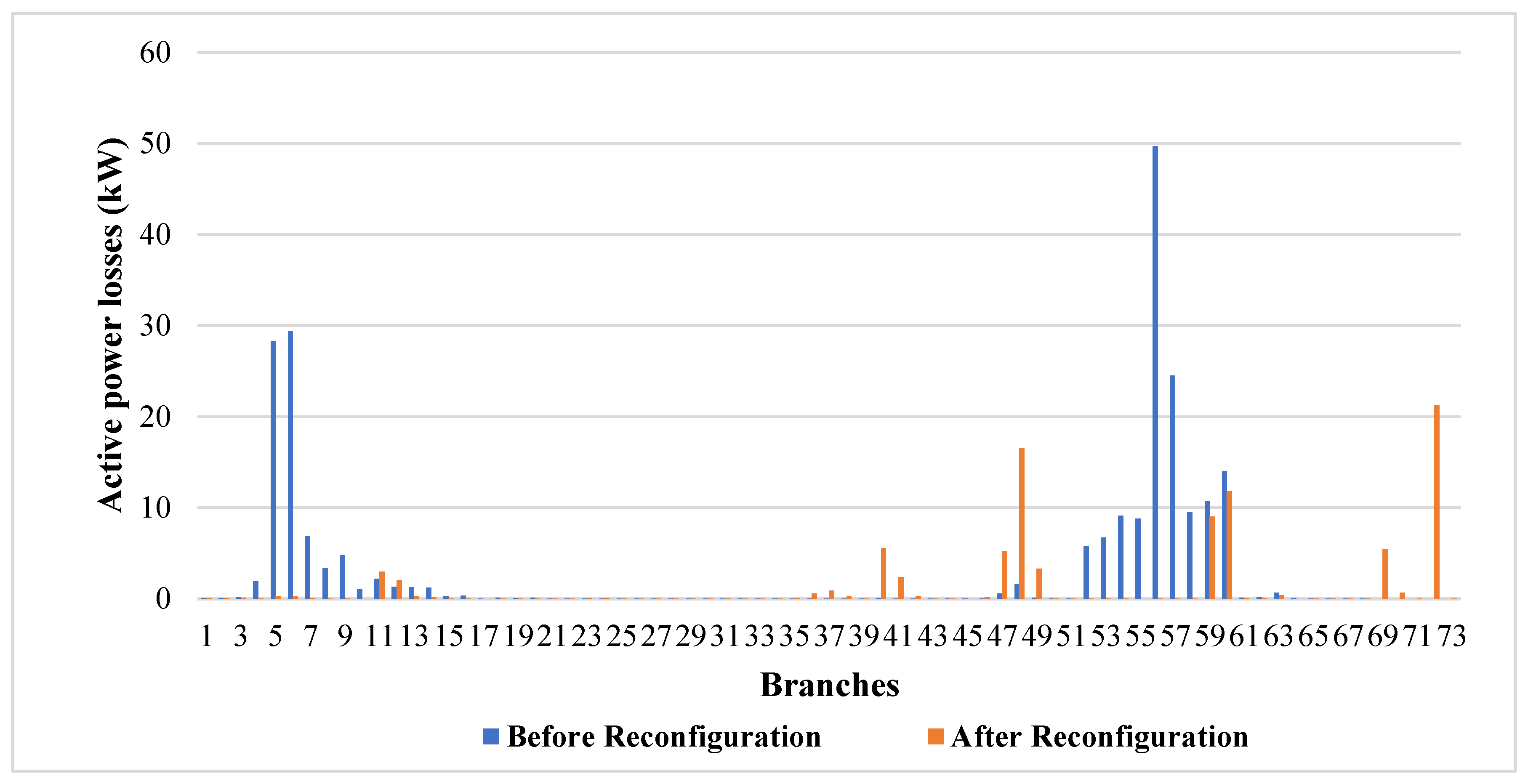

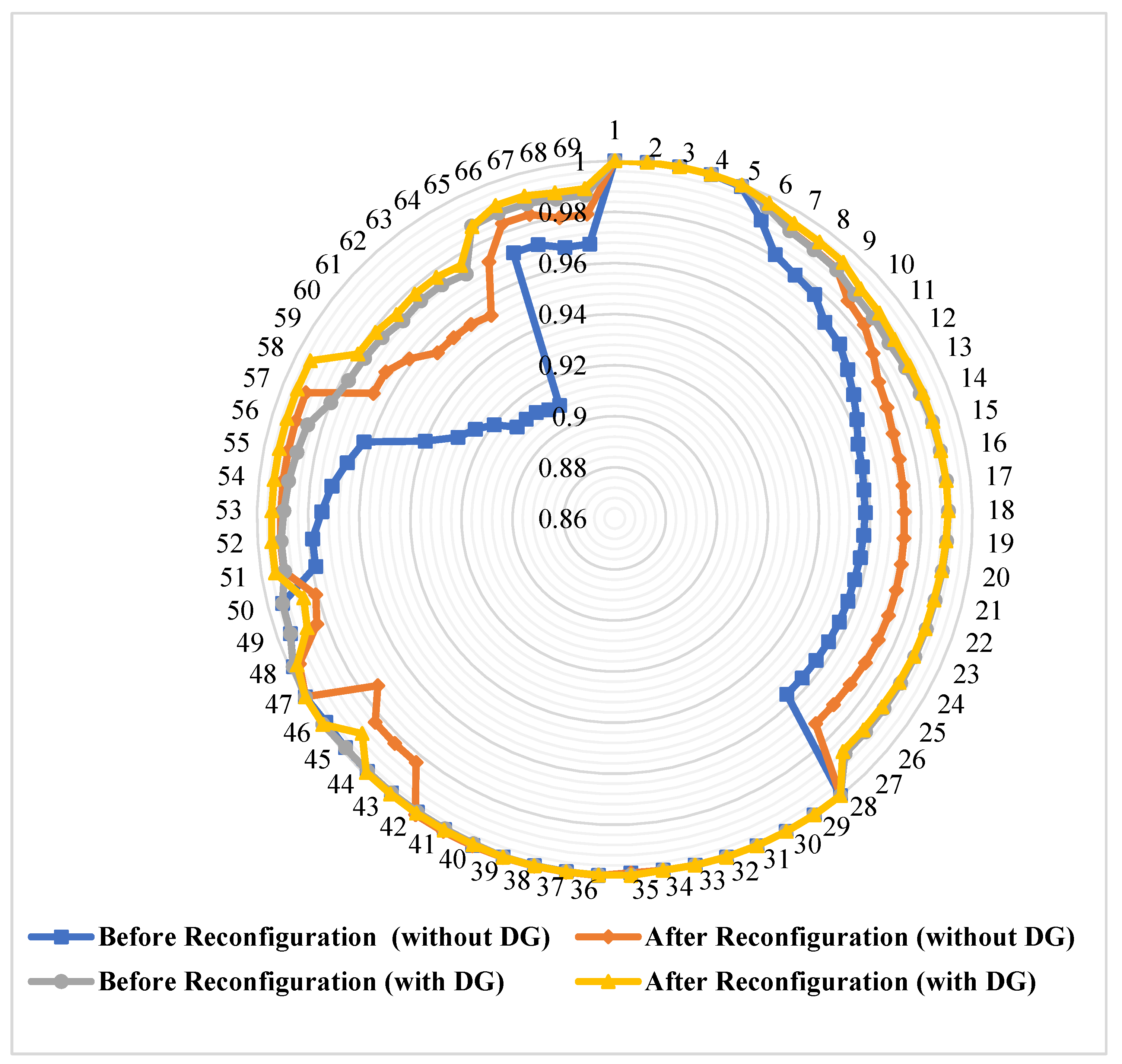
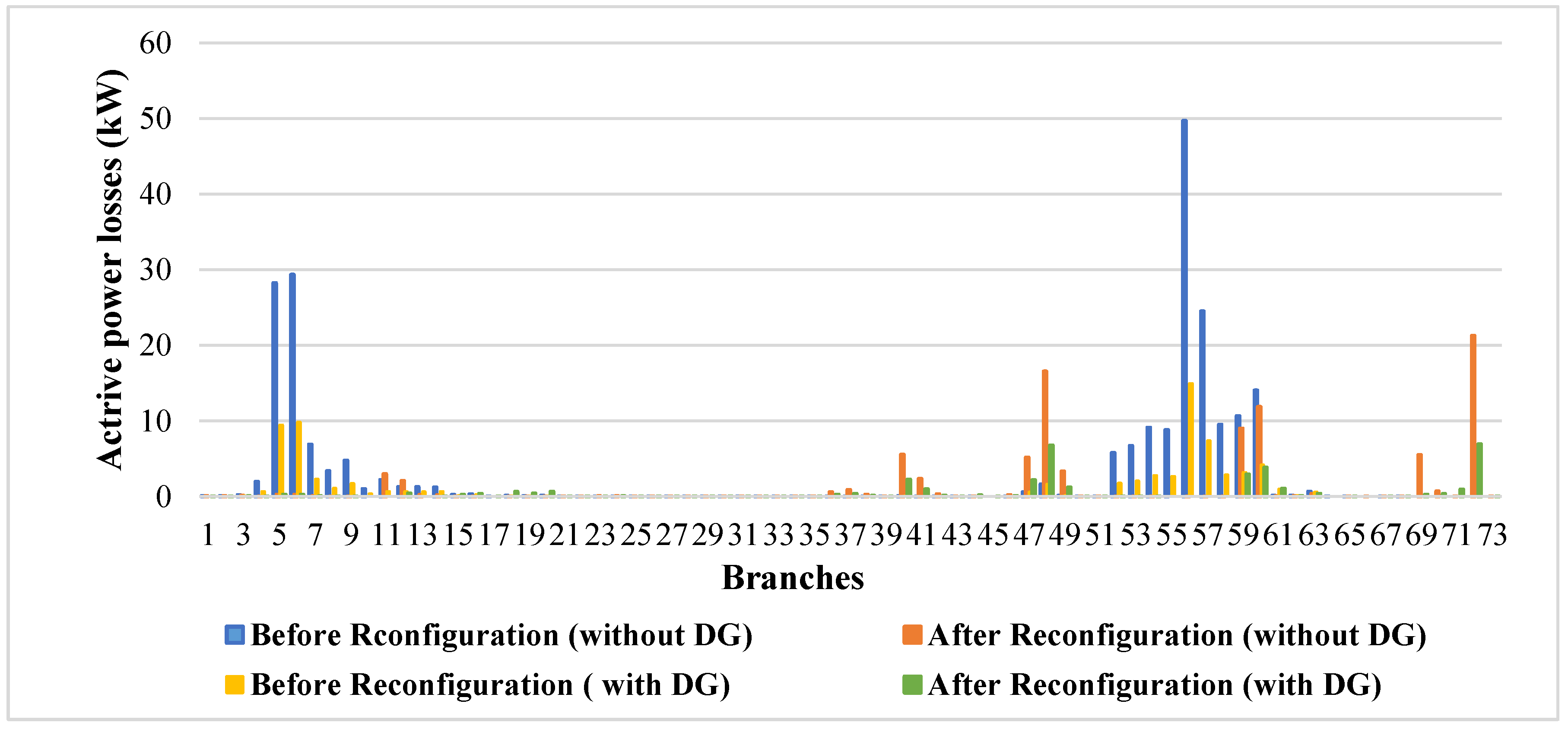

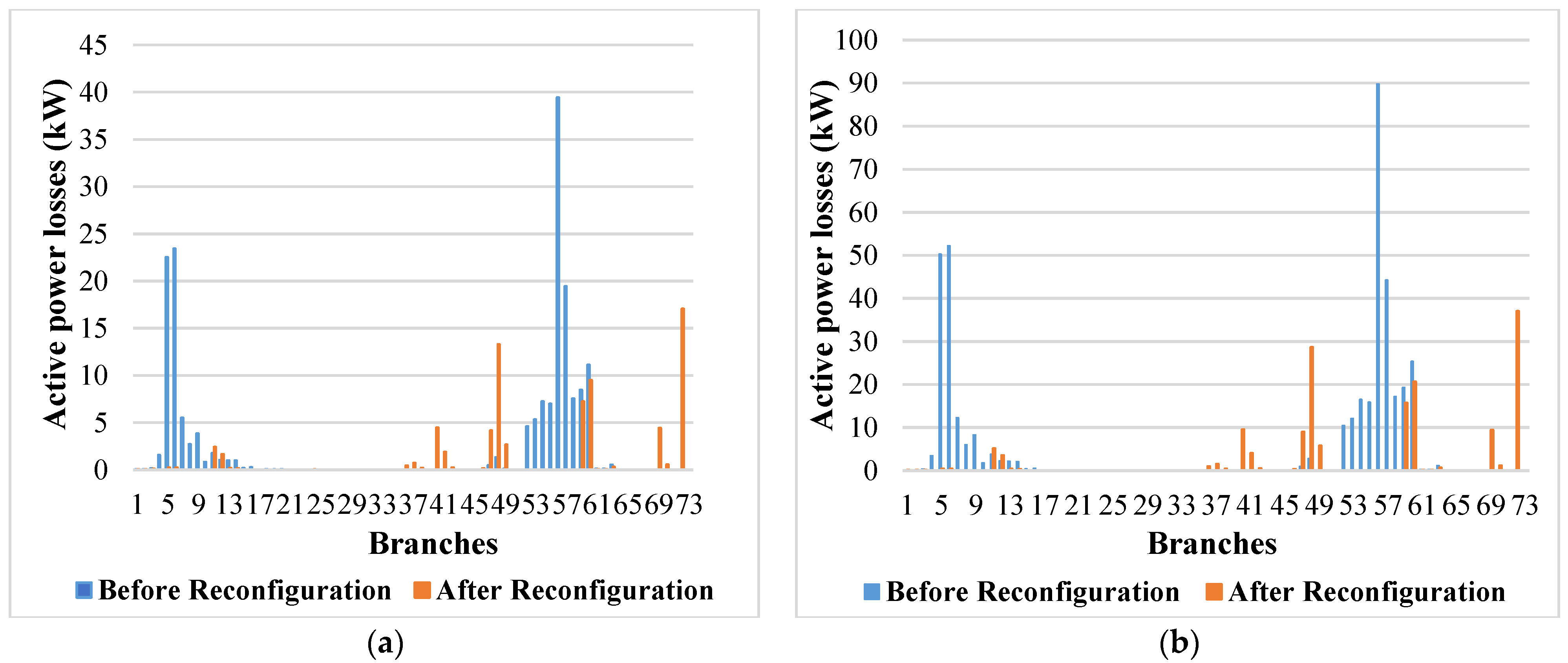

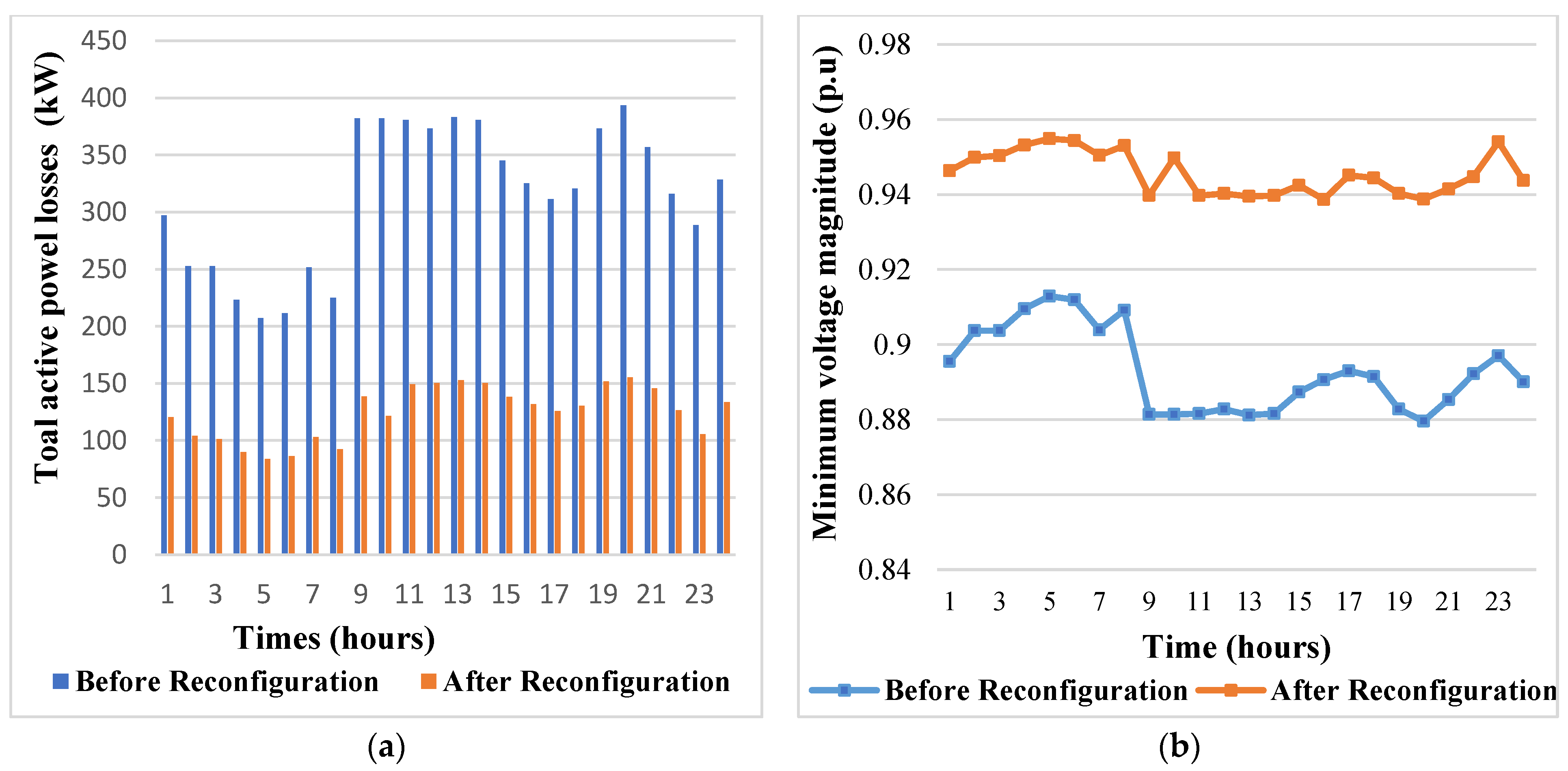

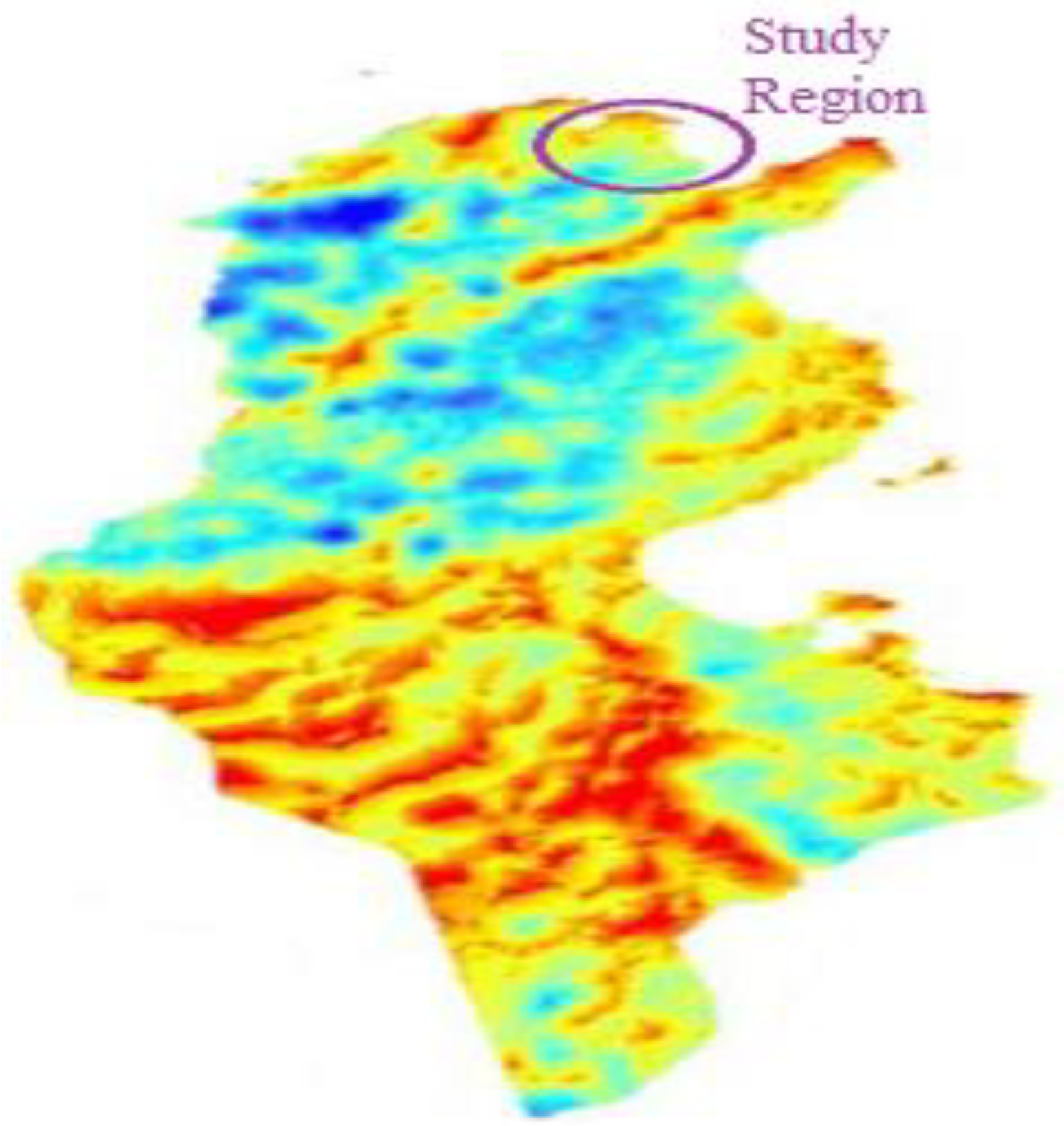
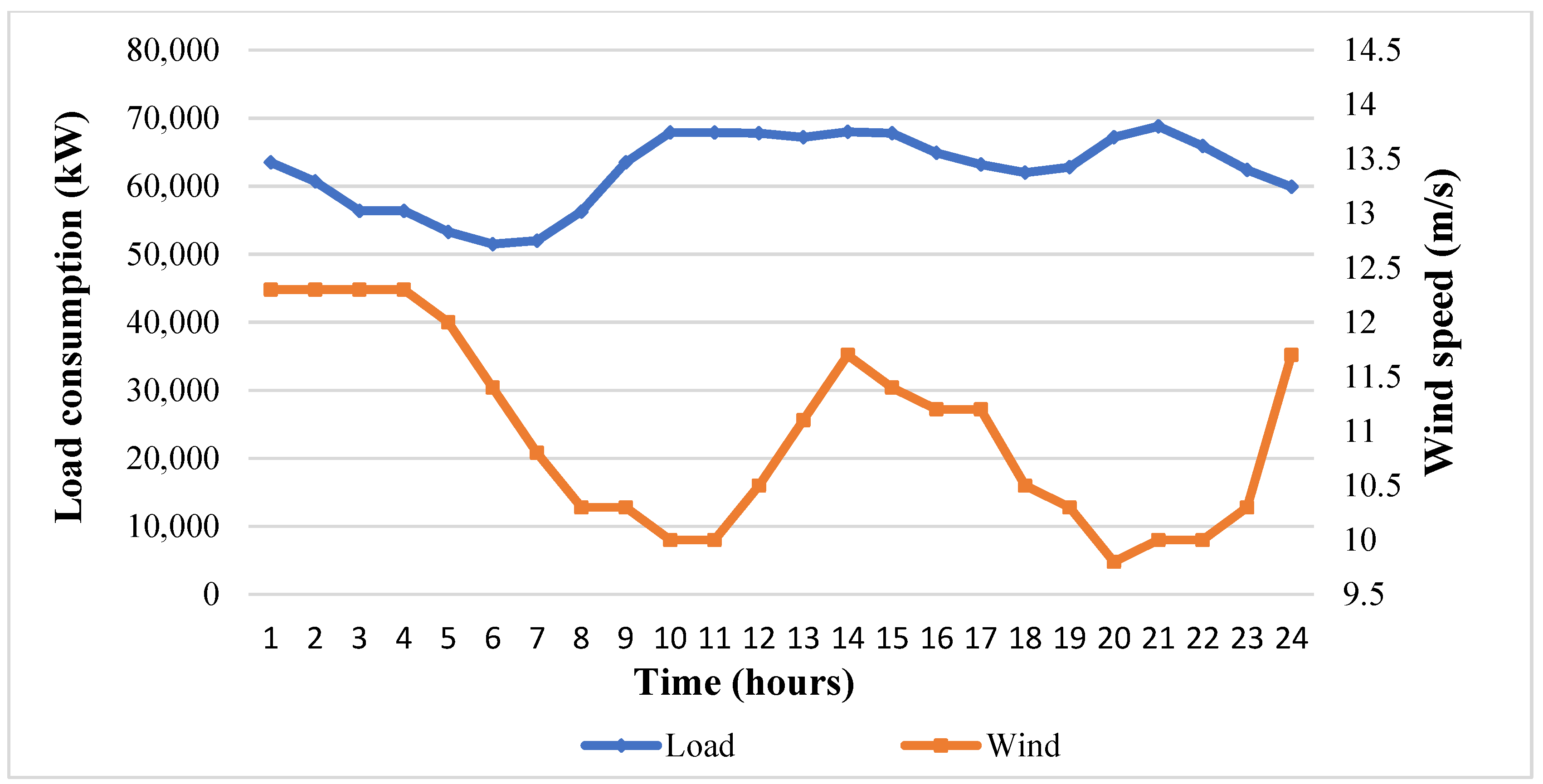
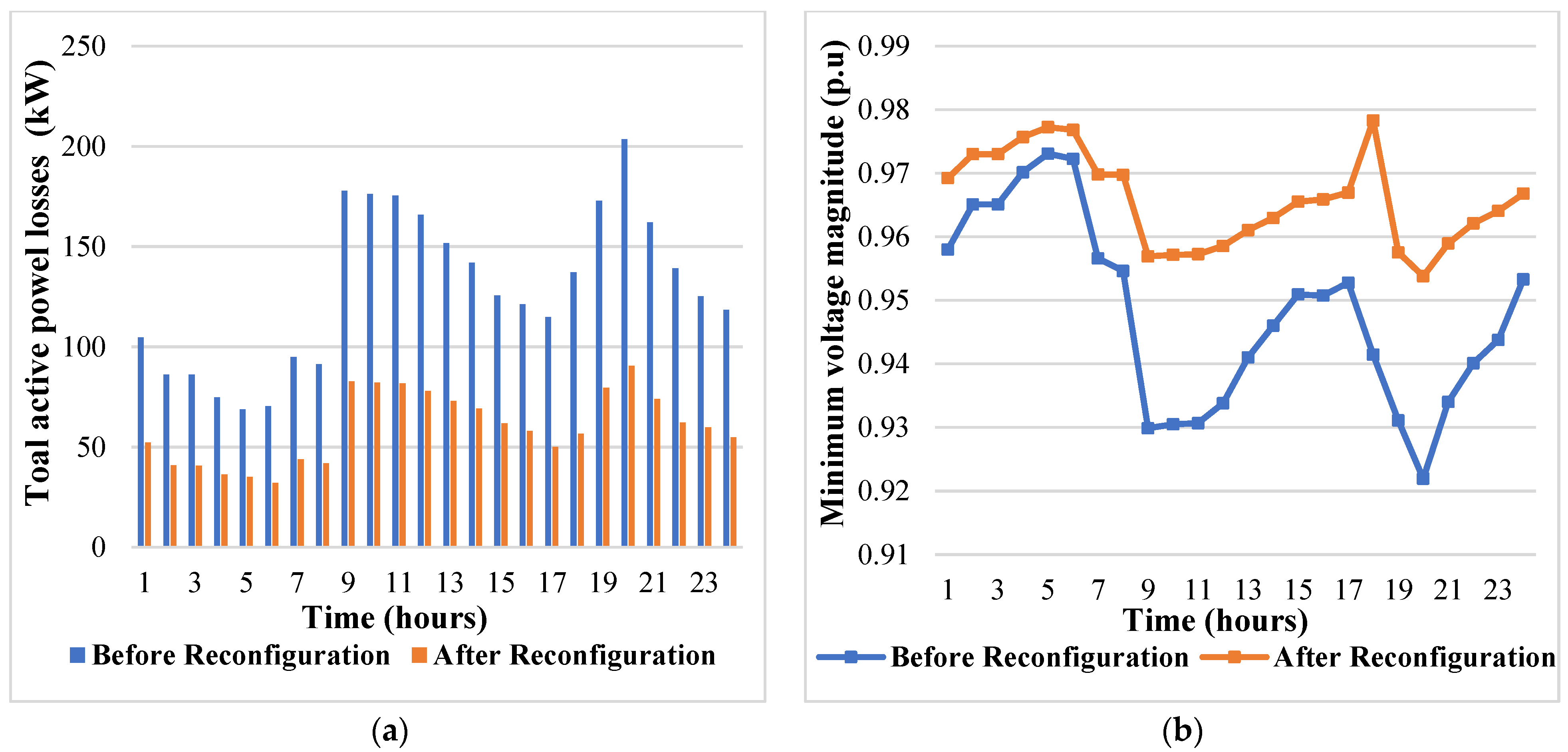
| Optimal Reconfiguration | Open Switches | Min. Voltage (pu) | TAPL (KW) | TAPL Reduction (%) | TAPL Saving (KW) | |
|---|---|---|---|---|---|---|
| Initial Topology | 69, 70, 71, 72, 73 | 0.9092 | 225.0007 | - | - | |
| Optimal Topology | HSA method in [47] | 14, 55, 61, 65, 70 | 0.9428 | 99.59 | 55.74 | 125.4107 |
| SSOE method in [48] | 13, 57, 61, 69, 70 | 0.9428 | 99.69 | 55.68 | 125.3107 | |
| MPSO method in [49] | 14, 58, 61, 69, 70 | 0.9523 | 98.86 | 56.062 | 126.14 | |
| BSPSO method in [50] | 14, 56, 61, 69, 70 | 0.9495 | 98.60 | 56.18 | 126.4007 | |
| SA method in [51] | 12, 19, 56, 63, 69 | 0.9410 | 96.97 | 56.9 | 128.0307 | |
| Proposed SAMPSO | 10, 17, 46, 56, 65 | 0.9530 | 85.6837 | 61.91 | 139.317 | |
| SAMPSO Reconfiguration | TAPL (kW) | TRPL (kVAR) | Min. Voltage | TAPL Reduction (%) | Tie-Switches | ||
|---|---|---|---|---|---|---|---|
| Voltage Value (pu) | Bus Num. | ||||||
| Case without DG Integration | Initial Topology | 225,0007 | 102.1647 | 0.9092 | 65 | - | 69, 70, 71, 72, 73 |
| Optimal Topology | 85.6837 | 113.5306 | 0.9530 | 64 | 61.91 | 10, 17, 45, 55, 64 | |
| Case with DG Integration | Initial Topology | 71.7401 | 37.4484 | 0.9719 | 64 | 68.16 | 69, 70, 71, 72, 73 |
| Optimal Topology | 30.8907 | 44.06194 | 0.9760 | 64 | 86.27 | 10, 11, 13, 57, 64 | |
| SAMPSO Reconfiguration | Results | Different Load Factors | |||
|---|---|---|---|---|---|
| Light (0.9) | Normal (1.0) | Heavy (1.3) | |||
| Initial Topology | TAPL (kW) | 178.9448 | 225.0007 | 403.2863 | |
| TRPL (kVAR) | 81.33799 | 102.1648 | 182.5133 | ||
| Min. volt « Vmin » | Value (pu) | 0.9191 | 0.9092 | 0.8781 | |
| Bus Num. | 65 | 65 | 65 | ||
| Optimal Topology | TAPL (kW) | 72.8517 | 85.6837 | 150.2000 | |
| TRPL (kVAR) | 91.2312 | 113.5306 | 196.6374 | ||
| Min. volt « Vmin » | Value (pu) | 0.9579 | 0.9530 | 0.9381 | |
| Bus Num. | 64 | 64 | 64 | ||
| TAPL réduction (%) | 59.2881 | 61.91 | 62.7559 | ||
| Tie Switchers | 10/17/45/56/64 | 10/17/45/55/64 | 10/17/45/58/64 | ||
| Hours | Before Reconfiguration | After Reconfiguration | TAPL Reduction (%) | Number of Switches Changes | |||||
|---|---|---|---|---|---|---|---|---|---|
| Tie-Switches | TAPL (kW) | Min. Volt « Vmin » | Tie-Switches | TAPL (kW) | Min. Volt « Vmin » | ||||
| 01.00 | 69, 70, 71, 72, 73 | 297.1639 | 0.895512 | 69/17/45/56/64 | 120.3527 | 0.946359 | 59.49955 | 1 | |
| 02.00 | 252.6092 | 0.903731 | 69/16/45/56/64 | 104.1738 | 0.949893 | 58.76088 | |||
| 3 | |||||||||
| 03.00 | 252.6092 | 0.903731 | 10/17/45/57/64 | 101.2358 | 0.950374 | 59.92393 | |||
| 1 | |||||||||
| 04.00 | 223.1851 | 0.909556 | 10/17/45/56/64 | 89.98635 | 0.953227 | 59.68085 | |||
| 1 | |||||||||
| 05.00 | 207.0485 | 0.912911 | 10/17/45/58/64 | 83.76805 | 0.954881 | 59.54182 | |||
| 2 | |||||||||
| 06.00 | 211.4775 | 0.911978 | 10/14/45/55/64 | 86.17345 | 0.95442 | 59.25173 | |||
| 3 | |||||||||
| 07.00 | 251.6089 | 0.903923 | 69/17/45/58/64 | 102.8454 | 0.950444 | 59.12491 | |||
| 2 | |||||||||
| 08.00 | 225.0007 | 0.909186 | 10/17/45/55/64 | 85.68373 | 0.953045 | 61.91864 | |||
| 3 | |||||||||
| 09.00 | 381.9756 | 0.881393 | 10/17/12/57/63 | 138.6104 | 0.939804 | 63.71223 | |||
| 4 | |||||||||
| 10.00 | 381.9756 | 0.881393 | 69/13/12/55/62 | 121.4813 | 0.949764 | 68.19659 | |||
| 4 | |||||||||
| 11.00 | 380.6849 | 0.881596 | 10/16/45/55/64 | 149.1105 | 0.939728 | 60.83100 | |||
| 4 | |||||||||
| 12.00 | 373.1327 | 0.882788 | 42/17/71/57/64 | 150.228 | 0.940263 | 59.73872 | |||
| 3 | |||||||||
| 13.00 | 383.2009 | 0.881201 | 69/17/45/55/64 | 152.7166 | 0.939512 | 60.14712 | |||
| 3 | |||||||||
| 14.00 | 380.6849 | 0.881596 | 10/13/45/58/64 | 150.3644 | 0.939728 | 60.50161 | |||
| 5 | |||||||||
| 15.00 | 345.0147 | 0.887335 | 69/17/71/54/63 | 138.2998 | 0.942458 | 59.91482 | |||
| 4 | |||||||||
| 16.00 | 325.0979 | 0.890666 | 10/17/45/57/62 | 131.9472 | 0.938675 | 59.41309 | |||
| 2 | |||||||||
| 17.00 | 311.4464 | 0.893008 | 69/17/45/57/64 | 125.7871 | 0.945151 | 59.61195 | |||
| 2 | |||||||||
| 18.00 | 320.5072 | 0.891448 | 42/17/71/57/64 | 130.3142 | 0.9444 | 59.34127 | |||
| 1 | |||||||||
| 19.00 | 373.1327 | 0.882788 | 42/17/45/57/64 | 151.6482 | 0.940263 | 59.35811 | |||
| 2 | |||||||||
| 20.00 | 393.5086 | 0.879597 | 9/17/45/55/64 | 155.1806 | 0.938784 | 60.56488 | |||
| 2 | |||||||||
| 21.00 | 357.008 | 0.885374 | 42/17/45/57/64 | 145.5237 | 0.941493 | 59.23798 | |||
| 3 | |||||||||
| 22.00 | 316.0172 | 0.892218 | 10/13/45/56/64 | 126.2721 | 0.944797 | 60.04266 | |||
| 4 | |||||||||
| 23.00 | 288.5165 | 0.897057 | 69/13/11/54/62 | 105.4203 | 0.954075 | 63.46126 | |||
| 5 | |||||||||
| 24.00 | 328.552 | 0.890082 | 41/19/71/56/64 | 133.5446 | 0.943744 | 59.35358 | |||
| Hours | Before Reconfiguration | After Reconfiguration | TAPL Reduction (%) | Number of Switches Changes | |||||
|---|---|---|---|---|---|---|---|---|---|
| Tie-Switches | TAPL (kW) | Min. Volt « Vmin » | Tie-Switches | TAPL (kW) | Min. Volt « Vmin » | ||||
| 01.00 | 69, 70, 71, 72, 73 | 104.7259 | 0.957975 | 41/14/45/58/64 | 52.23869 | 0.969227 | 50.11864 | 4 | |
| 02.00 | 86.30166 | 0.96509 | 10/16/11/56/64 | 40.93168 | 0.973008 | 52.57139 | |||
| 3 | |||||||||
| 03.00 | 86.30166 | 0.96509 | 10/13/45/55/64 | 40.84776 | 0.9757 | 52.66863 | |||
| 2 | |||||||||
| 04.00 | 74.86055 | 0.970152 | 10/14/43/55/64 | 36.35332 | 0.977243 | 51.43862 | |||
| 4 | |||||||||
| 05.00 | 68.88644 | 0.973075 | 42/13/45/57/64 | 35.14914 | 0.976825 | 48.97525 | |||
| 4 | |||||||||
| 06.00 | 70.50278 | 0.972261 | 10/70/11/56/64 | 32.24492 | 0.969809 | 54.26432 | |||
| 3 | |||||||||
| 07.00 | 95.04204 | 0.956604 | 10/14/45/55/64 | 44.04 | 0.969747 | 53.66261 | |||
| 1 | |||||||||
| 08.00 | 91.43782 | 0.954622 | 10/14/45/58/64 | 41.93565 | 0.956927 | 54.13752 | |||
| 2 | |||||||||
| 09.00 | 177.825 | 0.929879 | 41/15/45/58/64 | 82.78079 | 0.957154 | 53.44816 | |||
| 2 | |||||||||
| 10.00 | 176.1684 | 0.930494 | 42/15/45/56/64 | 82.16575 | 0.957245 | 53.35954 | |||
| 2 | |||||||||
| 11.00 | 175.431 | 0.930673 | 41/15/45/55/64 | 81.84752 | 0.958553 | 53.34489 | |||
| 1 | |||||||||
| 12.00 | 165.8212 | 0.933806 | 42/15/45/55/64 | 78.01013 | 0.961037 | 52.95527 | |||
| 1 | |||||||||
| 13.00 | 151.753 | 0.941009 | 42/15/45/56/64 | 73.09453 | 0.962956 | 51.83322 | |||
| 0 | |||||||||
| 14.00 | 141.8846 | 0.946 | 42/15/45/56/64 | 69.30393 | 0.965527 | 51.15473 | |||
| 2 | |||||||||
| 15.00 | 125.6644 | 0.950927 | 42/14/45/55/64 | 61.9205 | 0.965879 | 50.72552 | |||
| 2 | |||||||||
| 16.00 | 121.18 | 0.950747 | 69/16/45/57/64 | 58.11102 | 0.966951 | 52.04569 | |||
| 2 | |||||||||
| 17.00 | 114.9081 | 0.952777 | 69/16/12/58/64 | 50.03663 | 0.9638 | 56.45507 | |||
| 2 | |||||||||
| 18.00 | 137.0866 | 0.941446 | 69/16/12/55/63 | 56.62906 | 0.9783 | 58.69104 | |||
| 4 | |||||||||
| 19.00 | 172.7407 | 0.931113 | 69/17/45/57/64 | 79.70908 | 0.957558 | 53.85623 | |||
| 2 | |||||||||
| 20.00 | 203.4257 | 0.921945 | 69/14/45/56/64 | 90.58937 | 0.953789 | 55.46808 | |||
| 2 | |||||||||
| 21.00 | 161.9798 | 0.934014 | 69/15/45/55/64 | 74.0504 | 0.958957 | 54.28411 | |||
| 3 | |||||||||
| 22.00 | 139.0731 | 0.940083 | 10/13/45/55/64 | 62.3070 | 0.962101 | 55.19831 | |||
| 4 | |||||||||
| 23.00 | 125.2372 | 0.943787 | 15/42/45/58/64 | 59.8045 | 0.96408 | 52.247 | |||
| 5 | |||||||||
| 24.00 | 54.94408 | 0.95329 | 10/14/45/56/64 | 54.94408 | 0.966787 | 53.5728 | |||
Publisher’s Note: MDPI stays neutral with regard to jurisdictional claims in published maps and institutional affiliations. |
© 2022 by the authors. Licensee MDPI, Basel, Switzerland. This article is an open access article distributed under the terms and conditions of the Creative Commons Attribution (CC BY) license (https://creativecommons.org/licenses/by/4.0/).
Share and Cite
Sellami, R.; Khenissi, I.; Guesmi, T.; Alshammari, B.M.; Alqunun, K.; Alshammari, A.S.; Tlijani, K.; Neji, R. Optimal Reconfiguration of Distribution Network Considering Stochastic Wind Energy and Load Variation Using Hybrid SAMPSO Optimization Method. Sustainability 2022, 14, 11208. https://doi.org/10.3390/su141811208
Sellami R, Khenissi I, Guesmi T, Alshammari BM, Alqunun K, Alshammari AS, Tlijani K, Neji R. Optimal Reconfiguration of Distribution Network Considering Stochastic Wind Energy and Load Variation Using Hybrid SAMPSO Optimization Method. Sustainability. 2022; 14(18):11208. https://doi.org/10.3390/su141811208
Chicago/Turabian StyleSellami, Raida, Imene Khenissi, Tawfik Guesmi, Badr M. Alshammari, Khalid Alqunun, Ahmed S. Alshammari, Kamel Tlijani, and Rafik Neji. 2022. "Optimal Reconfiguration of Distribution Network Considering Stochastic Wind Energy and Load Variation Using Hybrid SAMPSO Optimization Method" Sustainability 14, no. 18: 11208. https://doi.org/10.3390/su141811208
APA StyleSellami, R., Khenissi, I., Guesmi, T., Alshammari, B. M., Alqunun, K., Alshammari, A. S., Tlijani, K., & Neji, R. (2022). Optimal Reconfiguration of Distribution Network Considering Stochastic Wind Energy and Load Variation Using Hybrid SAMPSO Optimization Method. Sustainability, 14(18), 11208. https://doi.org/10.3390/su141811208







